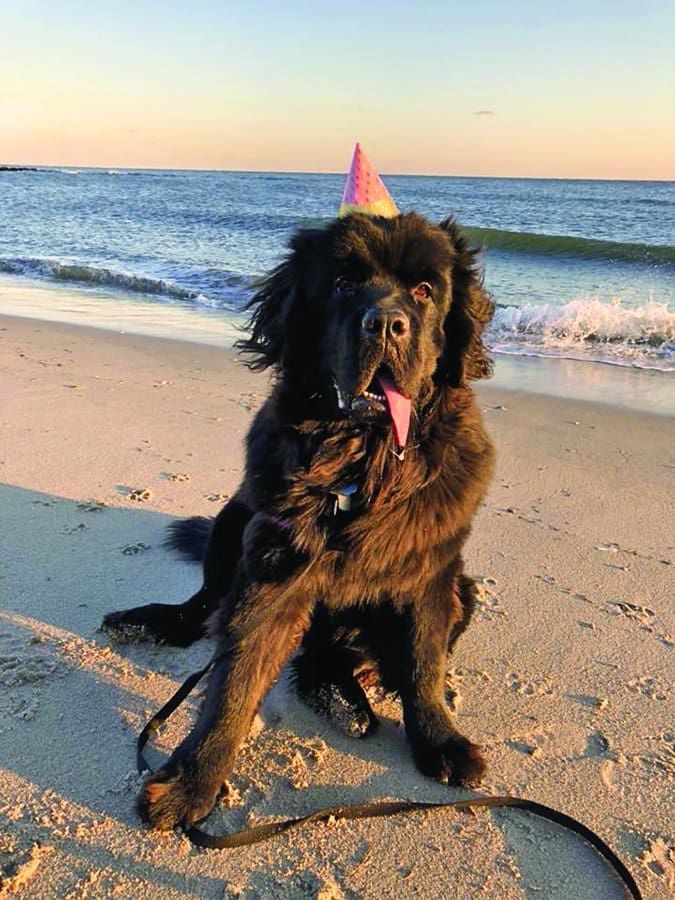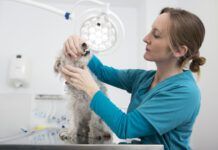At just eight months old, Sirius, my Newfoundland, partially tore the cranial cruciate ligament (CrCL) in her right knee. It was a shock to me, as she came from an excellent breeder, and because my partner and I had been very cautious about our puppy’s activity levels and kept her from doing anything even remotely high-impact.
Because of her age and the fact that her growth plates were not yet closed, we decided the best option for the time being was conservative management, rather than surgery. Sirius healed well for a time and was medically cleared to return to low-impact sport training.

Sassafras Lowrey
Multiple Cruciate Ligament Tears in One Dog
This past summer, at 20 months old, Sirius began limping again. Just as before, there was no precipitating incident, and we were being assiduous in maintaining her low-impact lifestyle; we always lifted her in and out of cars, etc. Yet diagnostics showed that she had – again – partially torn her right cranial cruciate ligament and significantly torn her left CrCL.
This time, thankfully, her growth plates were closed, making Sirius an ideal candidate for surgery. We began meeting with and interviewing veterinary surgeons.
At the time, we were living in a multi-story Brooklyn townhouse. For some time, my partner and I had been talking about a move to the West Coast; suddenly, this seemed like the perfect time to make the move. We realized that if we moved first and Sirius had the surgery there, she could have an easier rehabilitation than would be possible in a home with as many stairs as our townhouse. That’s how we came to spend a couple of weeks sleeping on an air mattress and living downstairs (since Sirius couldn’t do stairs) as we packed up our life and put our house on the market. Then we drove cross-country with our three dogs (and three cats!) to our new single-story home in Portland, Oregon.
Sirius’ TPLO Surgery Plan
As we learned in our independent research and from meeting with multiple veterinary surgeons, the TPLO surgery has become the gold-standard treatment for this kind of knee injury, especially in very large, strong, young, athletic dogs. While waiting for Sirius’ growth plates to close, we saw firsthand how conservative management worked – and then didn’t. We were looking for a treatment option that gave Sirius the best chance at the kind of fun and normal life she deserved, one that would allow her to return to the activities and sports training that she loved.
We had a surgical consultation scheduled for right after we arrived in Portland, and Sirius was scheduled to go in for surgery a few days later.

Sassafras Lowrey
Sirius had bilateral TPLO – both knees operated on at the same time. It was determined at the time of surgery that Sirius had one fully torn knee (left) and one partially torn knee (right, with scar tissue from the months of conservative management we had to do when she was too young for surgery).
In addition, the surgeon recommended one more procedure: a meniscus release in both knees. There are actually two menisci in each knee, and in some cases, they can become “caught” on protrusions from the tibia within the knee joint, causing further pain and injury. In the meniscus-release procedure, some connective tissue is severed to divide the menisci and ensure that they can no longer get caught. The procedure decreases the chances of a subsequent meniscal tear, so we told the surgeon to go ahead.
TPLO Surgery Recovery and Rehab for Dogs
I have to say – recovery was no joke. My partner and I both work from home, so we were able to arrange our schedules in order to provide Sirius with around-the-clock care and supervision when she came home from the hospital; this started the day after surgery. It was incredible to see how she was bearing weight already! We didn’t leave Sirius alone for a minute until the staples came out, 16 days after surgery.
The day after the staples were removed, we began weekly visits with a veterinary physical therapist. Sirius’ treatments included laser therapy, time on an underwater treadmill, and guided structured exercise. The latter was essential, as it also gave us a tailored daily exercise plan to work on at home, as well as a schedule for daily walks that increased in length and intensity under the guidance of her therapist.
Sirius had her final surgical recheck at eight weeks post-surgery and had new x-rays taken. Her knees had healed beautifully. In total, we had done eight sessions with a physical therapist before Sirius graduated and was fully cleared to resume all normal activities and all sport training.
Prior to her knee injuries, Sirius was swimming regularly. To be extra safe, we booked a consultation with a veterinary swim specialist at a dog pool/swim center, to ensure that she was still a strong and collected swimmer. It was determined that surgery had no impact on her swim style and that it was safe for her to resume regular swimming and begin water work training next season.
At nine weeks post-surgery, Sirius returned to low-impact Rally obedience training; at 13 weeks post-surgery she competed in her first Rally trial.
Today, at not quite five months post-surgery, Sirius’ quality of life is beyond what I could have imagined. She completed her Champion Trick Dog Title, has returned to Rally training, enjoys hiking and visiting the beach, walks for more than an hour a day, runs in the backyard with my other dogs, swims in rivers, and basically is loving life in the Pacific Northwest. TPLO surgery gave back my young, exuberant, athletic dog the ability to live life to its fullest.

Sassafras Lowrey
Sassafras Lowrey is an award-winning author and Certified Trick Dog Instructor. Sassafras’ forthcoming books include Tricks in the City: For Daring Dogs and the Humans That Love Them, Healing/Heeling, and Bedtime Stories for Rescue Dogs: William to the Rescue.







Inspiring, what a lovely story! We have just had our (very young) working labrador diagnosed with CCL, and are both devastated. It is really encouraging to hear there is life at the end of the very dark tunnel we are in.
Our Lab/Mastiff mix had a bilateral TPLO surgery just under two years of age, exactly one year ago from now, and he is doing absolutely amazing!! You would never know anything had been wrong with him!
How did your dog get around to use the bathroom if both legs were operated on at the same time? My 74 lbs. mix needs TPLO surgery on his rear left and is scheduled for February 5th. However he seems to have torn the other CCL yesterday and can barely stand. I will try to get him seen again tomorrow as the vet is closed today. I’m happily pregnant but can’t lift him to help him and wonder if a wheelchair is a good temporary option. I’m glad it worked out for your baby and appreciate any feedback.
Just wondering if you received any more information. My 10 year old Janie ruptured her right CCL in January 8. Today is February 8 and she ruptured the left one this morning. Surgery for the right leg has been scheduled for February 17. I don’t know what the vet will recommend in terms of whether to do both at the same time. Also wondering about wheelchair. Hope everything works out well for you and for me and our doggies. It’s a looooong process!
Our dog Lacey is scheduled for TPLO surgery for her left stifle on Aug 25th, one day from posting this reply. Last night, less than 36 hours from her surgery, her right leg gave out. She hasn’t been able to go potty since, and I don’t know how to help her go. Does anyone have some advise?
My Dog had double TPLO surgury and is functional 4 months after the surgury. She plays with the other pup again and it’s amazing to see, but she is still not the same as she was. Not sure she ever will be, but I’m hopeful.
My Bella is seeing a orthopaedic surgeon this week the vets thinks Bella has damage both cruciate ligaments. Please can i ask you how would a dog go to the toilet if both legs are done at the same time.
We are having to do the same surgery for both knees on our dog. Where did you go in Portland? We live there! Thank you and I am very glad to hear your dog did so well!
We went to Companion pet clinic in.Vamcouver and had a good experience.
This story sounds exactly like my pup, Mila (60lb GSD / Malanois mix, @batdogmila). She had a collision at 9 months (11/2020), cried in pain, limped away, then was fine next week… then suddenly severe limping came back at 21 months (worse on left than right side). I just had TPLO done today (12/2021) on only her left leg, they said swelling is present but not instable on the right. happy with my decision so far to do only 1 leg… but we will see how results go since 30-50% have to have the next leg done too because of weight compensation.
Same issue happened with out 8 y.o. yellow lab. First, a torn ligament in the back left leg, then a few weeks later (just yesterday, in fact) the back-right leg has given out, as well. It is a challenge getting him outside to do his business, and it has only been a couple days!
It seems surgery is very likely, I’m just not sure if it will be both legs, or just one. I’m posting here so that I can share any details that will help others. More info to come after we see the doc.